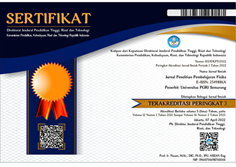Advancing Dermatological Image Classification: GLCM-Based Machine Learning Insights
DOI:
https://doi.org/10.26877/asset.v7i1.1154Keywords:
Skin cancer, AI in healthcare, Classification, HAM dataset, sustainable technologyAbstract
The prospects to improve skin illness via the utilization of artificial intelligence algorithms is what renders this study economically important. Machine learning may assist physicians detect people quicker and more accurately. The effective identification of skin disorders using machine learning could result in the development of large and readily available digital tests. A model was used in the present study to analyze the HAM 10000 data. Two hundred images in total were chosen at random; one hundred showed dermatofibroma diseases, whereas the other hundred displayed benign keratosis. Subsequently, these images were resized to prepare for additional examination. The statistical features of the gray level co-occurrence matrix were calculated from the image dataset by changing the distances 0, 5, 10, 15 and angles 0°, 45°, 90°, 135°. Five different machine learning models were subsequently trained and assessed based on these features. The study shows that the logistic regression model accurately detects and classifies various skin diseases. The logistic regression model showed exceptional performance, exceeding the expected results in terms of accuracy 91.50%, sensitivity 93.00%, and F1-score 91.36. The results of the study were most favorable when using an angle measurement of 135°.
References
[1] Salsabila, A.S., C.A. Sari, and E.H. Rachmawanto, Classification of Movie Recommendation on Netflix Using Random Forest Algorithm. Advance Sustainable Science, Engineering and Technology, 2024. 6(3).
[2] Edwar, D.A., I.N. Naji, and H.M. Aboul-Ela, Investigation the Role of Various Antiseptics on the Prevalence of Skin Microbiota and Post Cesarean Surgery Infections. Al-Mustansiriyah Journal of Science, 2023. 34(3): p. 1-9.
[3] Hosny, K.M., M.A. Kassem, and M.M. Fouad, Classification of Skin Lesions into Seven Classes Using Transfer Learning with AlexNet. Journal of Digital Imaging, 2020. 33(5): p. 1325-1334.
[4] Keerthana, D., et al., Hybrid convolutional neural networks with SVM classifier for classification of skin cancer. Biomedical Engineering Advances, 2023. 5: p. 100069.
[5] Mobiny, A., A. Singh, and H. Van Nguyen, Risk-aware machine learning classifier for skin lesion diagnosis. Journal of Clinical Medicine, 2019. 8(8).
[6] Hasan, M.K., et al., A survey, review, and future trends of skin lesion segmentation and classification. Computers in Biology and Medicine, 2023: p. 106624.
[7] Tschandl, P., et al., Comparison of the accuracy of human readers versus machine-learning algorithms for pigmented skin lesion classification: an open, web-based, international, diagnostic study. The Lancet Oncology, 2019. 20(7): p. 938-947.
[8] Shames, M.A. and M.Y. Kamil, Lung Infection Detection via CT Images and Transfer Learning Techniques in Deep Learning. Journal of Advanced Research in Applied Sciences and Engineering Technology, 2025. 47(1): p. 206-218.
[9] Ahammed, M., M.A. Mamun, and M.S. Uddin, A machine learning approach for skin disease detection and classification using image segmentation. Healthcare Analytics, 2022. 2.
[10] Kadhim, R.R. and M.Y. Kamil, Breast invasive ductal carcinoma diagnosis using machine learning models and Gabor filter method of histology images. International Journal of Reconfigurable and Embedded Systems, 2023. 12(1): p. 9-18.
[11] Alam, L. and A.Z. Fanani, Implementation of the Adaboost Method to Increase the Accuracy of Early Diabetes Predictions to Prevent Death Decision Tree-Based. Advance Sustainable Science, Engineering and Technology, 2024. 6(2).
[12] Qiu, X., et al., Raman spectroscopy combined with deep learning for rapid detection of melanoma at the single cell level. Spectrochimica Acta Part A: Molecular and Biomolecular Spectroscopy, 2023. 286: p. 122029.
[13] Omeroglu, A.N., et al., A novel soft attention-based multi-modal deep learning framework for multi-label skin lesion classification. Engineering Applications of Artificial Intelligence, 2023. 120: p. 105897.
[14] Al-Khuzaay, H.M., et al., Evaluation of Effect of β-Glucan on Cancer Cell Lines In vitro. Al-Mustansiriyah Journal of Science, 2024. 35(1): p. 17-20.
[15] Choudhary, P., J. Singhai, and J.S. Yadav, Skin lesion detection based on deep neural networks. Chemometrics and Intelligent Laboratory Systems, 2022. 230: p. 104659.
[16] Kamil, M.Y. and A.L.A. Jassam. Analysis of Tissue Abnormality in Mammography Images Using Gray Level Co-occurrence Matrix Method. in Journal of Physics: Conference Series. 2020.
[17] Hashem, S.A. and M.Y. Kamil, Segmentation of Chest X-Ray Images Using U-Net Model. Mendel, 2022. 28(2): p. 49-53.
[18] Obaid, A.S., M.Y. Kamil, and B.H. Hamza, People Recognition via Tongue Print Using Deep and Machine Learning. Journal of Artificial Intelligence and Technology, 2023. 3(3): p. 119-125.
[19] Said, R.A., et al. Skin Cancer Detection and Classification Based on Deep Learning. in International Conference on Cyber Resilience, ICCR 2022. 2022.
[20] Mohammed, N.B., et al., Quantitative Analysis of Blurry Color Image Fusion Techniques using Color Transform. Al-Mustansiriyah Journal of Science, 2023. 34(3): p. 132-140.
[21] Thabit, Z.H., S.A. Mehdi, and B.M. Nema, Enhancing Color Image Security: Encryption with Dynamic Chaotic Three-Dimensional System and Robust Security Analysis. Al-Mustansiriyah Journal of Science, 2023. 34(4): p. 87-95.
[22] Nakai, K., Y.-W. Chen, and X.-H. Han, Enhanced deep bottleneck transformer model for skin lesion classification. Biomedical Signal Processing and Control, 2022. 78: p. 103997.
[23] Shames, M.A. and M.Y. Kamil, Early Diagnosis of Lung Infection via Deep Learning Approach. International Research Journal of Multidisciplinary Technovation, 2024. 6(3): p. 216-224.











